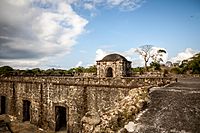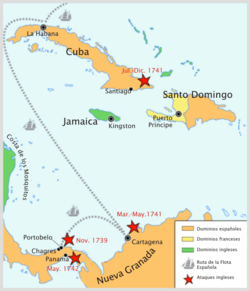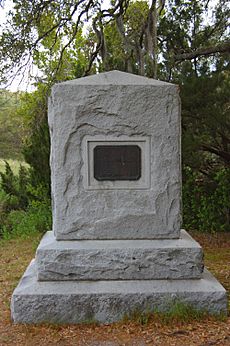War of Jenkins' Ear facts for kids
Quick facts for kids War of Jenkins' Ear |
|||||||
|---|---|---|---|---|---|---|---|
| Part of the War of the Austrian Succession | |||||||
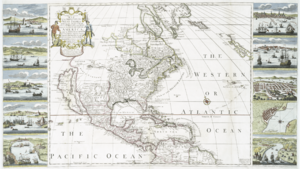 Trade map of the West Indies and North America during the war, 1741 |
|||||||
|
|||||||
| Belligerents | |||||||
| Commanders and leaders | |||||||
| Casualties and losses | |||||||
1739–1741:
1741–1744: 30,000 dead, 407 ships lost |
1739–1748: 4,500 dead, 5,000 wounded, 186 ships lost |
||||||
The War of Jenkins' Ear was a conflict between Britain and Spain. It lasted from 1739 to 1748. Most of the fighting happened in New Granada and the Caribbean Sea. Major battles largely ended by 1742. This war was connected to the War of the Austrian Succession, which took place from 1740 to 1748.
The war's unusual name came from British historian Thomas Carlyle in 1858. It refers to Robert Jenkins, a British ship captain. His ear was supposedly cut off by Spanish coast guards in April 1731. This happened while they were searching his ship, the Rebecca, for illegal goods.
At first, people didn't react much to the incident. But seven years later, politicians in Britain's Parliament used it. They were supported by the South Sea Company. They wanted to start a war with Spain. Their goal was to get better trading chances in the Caribbean. They also wanted to keep the profitable Asiento de Negros. This was a special agreement that let British slave traders sell slaves in Spanish America. Because of this, the Spanish call it the Guerra del Asiento (War of the Asiento).
In 1741, British attacks on the ports of Cartagena and Havana failed. Many soldiers died, mostly from disease. These large attacks were not tried again. After 1742, the conflict mostly became part of the larger War of the Austrian Succession. That war involved most European powers. Both wars ended with the 1748 Treaty of Aix-la-Chapelle. The War of Jenkins' Ear is remembered in British naval history for Admiral George Anson's voyage around the world. He sailed from 1740 to 1744.
Contents
- Why the War Started
- What's in a Name?
- How the War Was Fought
- What Happened After the War
- See also
- Sources
Why the War Started
This war was often seen as a fight between Britain and Spain. They disagreed over who could trade in Spanish America. But newer historians say trade was just one reason. Tensions also grew because Britain was expanding its colonies in North America. The main reason for war was a political campaign in Britain. It aimed to remove the government led by Robert Walpole, who had been Prime Minister since 1721.
Trade and Treaties
In the 1700s, people believed trade was a limited resource. Countries thought they could only gain trade by taking it from rivals. So, wars often happened over business issues. The 1713 Treaty of Utrecht gave British merchants access to Spanish American markets. This included the Asiento de Negros. It was a special right to supply 5,000 slaves each year. Another right was the Navio de Permiso. This allowed two ships a year to sell 500 tons of goods each. They could sell in Porto Bello in Panama and Veracruz in Mexico. The South Sea Company got these rights. The British government took control of this company in 1720.
However, these rights were not as valuable as trade between Britain and Spain itself. This trade was very important to British merchants. The asiento itself made little profit. Its main use was to hide illegal goods. Spanish colonists wanted more goods than allowed, so a large black market grew. Spain tried to control this illegal trade. Sometimes, they even used it as a political tool.
The Ear Incident and Growing Tensions
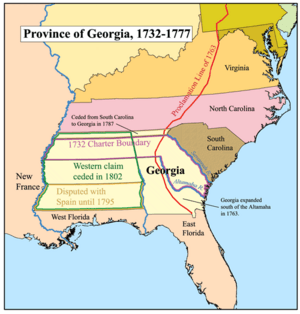
The 1729 Treaty of Seville let Spanish ships search British vessels in the Americas for illegal goods. In 1731, the Rebecca was stopped near Cuba. It was carrying illegal sugar. Captain Robert Jenkins later claimed he was tortured. He said his ear was partly cut off by Spanish coast guards. British naval officers knew about this illegal trade. They said traders could not complain if their goods were taken. Such incidents were just part of doing business. The ear incident was soon forgotten when Spain eased trade rules in 1732.
Tensions rose again after Britain founded the colony of Georgia in 1732. Spain saw this as a threat to Spanish Florida. Florida was important for protecting shipping routes to Spain. In 1738, more Spanish "depredations" (attacks on ships) led to demands for payment. British politicians who opposed the government used these events. They linked them to France to make the government look weak. They even brought Jenkins to the House of Commons. He showed his ear there, making the incident famous.
In January 1739, the Convention of Pardo was signed. It aimed to solve the Georgia-Florida border dispute. Spain agreed to pay £95,000 for seized ships. But the South Sea Company refused to pay Spain its share of profits. So, war became unavoidable. On October 23, 1739, Britain officially declared war.
What's in a Name?
The event that gave the war its name happened in 1731. It was off the coast of Florida. A Spanish patrol boat, La Isabela, stopped the British ship Rebecca. The Spanish commander, Juan de León Fandiño, cut off the left ear of the Rebecca's captain, Robert Jenkins. Fandiño accused Jenkins of smuggling. He told Jenkins, "Go, and tell your King that I will do the same, if he dares to do the same."
In March 1738, Jenkins was asked to speak before Parliament. He was supposed to tell his story to the House of Commons. Some stories say he showed his severed ear. This incident, along with others, was seen as an insult to Britain's honor. It was considered a clear reason for war.
The conflict was named by historian Thomas Carlyle in 1858. This was 110 years after the war ended. Carlyle wrote about "the War of Jenkins's Ear" in his book History of Friedrich II.
How the War Was Fought
Early British Attacks
First Attack on La Guaira (October 22, 1739)
Admiral Vernon sent three ships to attack Spanish vessels. Captain Thomas Waterhouse led them. He tried to trick the Spanish by flying their flag. But the Spanish gunners at La Guaira were ready. They waited until the British ships were close. Then they fired all at once. After three hours of heavy fighting, Waterhouse had to retreat. His ships were badly damaged.
Capture of Portobelo (November 20–22, 1739)
Before 1739, Spain's trade with its colonies went through specific ports. Ships gathered in Cadiz twice a year. Then, the Flota (fleet) sailed to Portobelo or Veracruz. Attacking these ports would hurt Spanish trade.
On November 22, 1739, Admiral Vernon attacked Portobelo with six warships. The port fell in less than a day. The British stayed for three weeks. They destroyed its forts, port, and warehouses before leaving. This victory was greatly celebrated in Britain. The song "Rule Britannia" was written to mark the occasion. Many places in Britain were named after this success. However, the Spanish later changed their trade routes. Portobelo's economy did not recover for nearly two centuries.
First Attack on Cartagena de Indias (March 13–20, 1740)
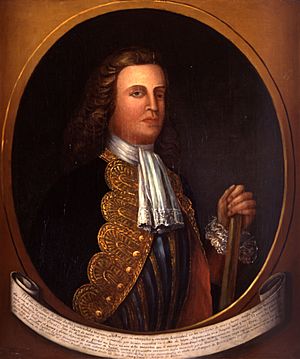
After taking Portobelo, Vernon wanted to capture Cartagena de Indias in Colombia. This was a key Spanish gold shipping port. Vernon tried to gather information about Cartagena's defenses. On March 7, 1740, Vernon led a squadron of ships to Cartagena. He landed men to map the area. On March 18, he ordered his bomb vessels to fire on the city. He wanted to see how the Spanish would react. The Spanish commander, Blas de Lezo, did not respond right away. He moved guns from his ships to create temporary shore defenses. The British tried an amphibious assault (landing troops from ships). But they faced strong resistance and failed. The British then shelled the city for three days. After 21 days, Vernon withdrew his forces.
Destruction of San Lorenzo el Real Chagres (March 22–24, 1740)
Vernon then attacked the fortress of San Lorenzo el Real Chagres in Panama. This was near Portobelo. The fort had four guns and about 30 soldiers. On March 22, 1740, Vernon's large squadron began to bombard the fort. The Spanish commander surrendered on March 24, after two days of fighting. The British destroyed the fort and took its guns.
While the British were winning in the Caribbean, Spain made an important move. They replaced the governor of Cartagena de Indias. The new governor, Sebastián de Eslava, had to avoid the British navy. He sailed from Spain and reached Cartagena on April 21, 1740. He brought several hundred experienced soldiers with him.
Second Attack on Cartagena de Indias (May 3, 1740)
In May, Vernon returned to Cartagena with 13 warships. He planned to bombard the city. Lezo, the Spanish commander, positioned his six warships cleverly. This forced the British fleet to fire from far away, which was not effective. Vernon withdrew, saying it was just a practice move. This attack helped the Spanish test their defenses.
The Big Battle for Cartagena (March 13 – May 20, 1741)
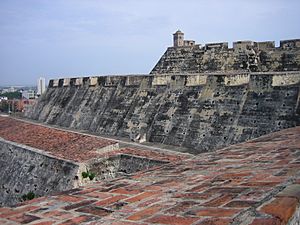
The biggest battle of the war was a huge attack by sea and land on Cartagena de Indias. Admiral Edward Vernon led the British in March 1741. Cartagena was one of Spain's main gold-trading ports. Vernon's expedition faced many problems. There was poor organization and rivalry between commanders. Also, it was hard to supply such a large force across the Atlantic.
The strong forts in Cartagena and the smart plans of Spanish Commander Blas de Lezo stopped the attack. The British suffered heavy losses. Most deaths were from tropical diseases, especially yellow fever. More soldiers died from sickness than in battle.
The British had easily destroyed Porto Bello. This made them change their plans. Instead of attacking Havana, they decided to attack Cartagena de Indias. It was the main port for the West Indian fleet sailing to Spain. For this attack, the British gathered one of the largest fleets ever. It had 186 ships, more than the famous Spanish Armada. It carried 2,620 cannons and over 27,000 men. This included 10,000 soldiers, 12,600 sailors, and 4,000 recruits from Virginia. These Virginians were led by Lawrence Washington, the older half-brother of George Washington.
Admiral Blas de Lezo was in charge of defending Cartagena. He was a tough naval veteran. He had fought in many battles in Europe and against pirates. He had only six warships and 3,000 soldiers.
On March 13, 1741, the British landed troops. They began to attack Fort de San Luis de Bocachica. British ships fired cannons at the fort. Lezo ordered some of his ships to help defend. But the Spanish had to retreat to the city. Many civilians were already leaving. The Spanish regrouped at Fort San Felipe de Barajas. Vernon thought he had won. He sent a message to Jamaica saying he had taken the city. This news caused big celebrations in London. Medals were even made showing Vernon defeating the Spanish. The medals showed a strong enemy, but Admiral Lezo was actually missing an eye and was lame from past battles.
On April 19, the British launched a big attack on Fort San Felipe de Barajas. They moved in the dark, helped by heavy cannon fire from their ships. The British reached the base of the fort's walls. But they found the Spanish had dug deep trenches. This made the British scaling ladders too short. The British were stuck. They couldn't climb the walls, and they couldn't easily retreat under heavy Spanish fire. The Spanish took advantage of this.
At dawn, the Spanish charged with fixed bayonets. They caused huge losses for the British. The surviving British soldiers retreated to their ships. The British kept firing cannons. They sank what was left of the small Spanish fleet. The Spanish had sunk some of their own ships to block the harbor entrance. The Spanish stopped any more British attempts to land troops. British soldiers had to stay on their crowded ships for a month. Supplies ran low, and diseases like yellow fever spread. Many died. Vernon had to give up the siege on May 9 and return to Jamaica. Six thousand British soldiers died, while only one thousand Spanish soldiers were lost.
Vernon continued to attack other Spanish places. He attacked Guantánamo Bay in Cuba. In 1742, he was replaced by Rear-Admiral Chaloner Ogle. Vernon returned to England. The defeat at Cartagena was a big reason why British Prime Minister Robert Walpole lost power.
Anson's Journey Around the World
After the success at Porto Bello, Britain sent a squadron under Commodore George Anson in September 1740. His mission was to attack Spain's lands in the Pacific. Many of his men died from disease before they reached the Pacific. They were too weak to attack. Anson regrouped his forces. He then raided the town of Paita on the Chilean coast. He reached Acapulco too late to catch the yearly Manila galleon. This ship was one of his main targets. He sailed across the Pacific and faced a storm. He had to stop for repairs in Canton. The next year, he tried again to intercept the Manila galleon. On June 20, 1743, he succeeded off Cape Espiritu Santo. He captured over a million gold coins.
Anson sailed home, arriving in London more than three and a half years after he started. He had sailed around the world. Less than a tenth of his original crew survived. Anson's success made him famous and wealthy in Britain. He was later made First Lord of the Admiralty.
Fighting in Florida
In 1740, people from the British colony of Georgia attacked St. Augustine in Florida. British ships also blocked the city by sea. But the attack failed. The British forces, led by James Oglethorpe, besieged St. Augustine for over a month. They had to retreat and left their cannons behind. The British navy failed to stop supplies from reaching the city. This was a key reason the siege failed. Oglethorpe then prepared Georgia for a Spanish attack. The Battle of Bloody Mose, where Spanish and free black forces fought off Oglethorpe, was also part of this war.
Spanish Invasion of Georgia
In 1742, Spain tried to take the British colony of Georgia. Manuel de Montiano led 2,000 troops. They landed on St Simons Island. General Oglethorpe gathered local forces. He defeated the Spanish soldiers at Bloody Marsh and Gully Hole Creek. This forced the Spanish to leave. Small border fights continued for a few years. But neither Spain nor Britain launched big attacks on the North American mainland again.
Second Attack on La Guaira (March 2, 1743)
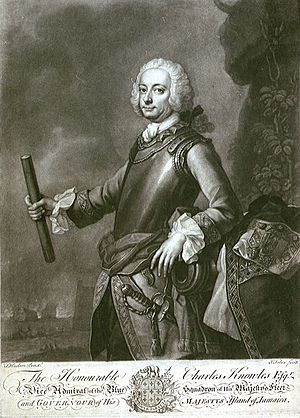
The British attacked several places in the Caribbean. But these attacks did not change the overall situation much. The weakened British forces under Vernon attacked Cuba. They landed in Guantánamo Bay. They planned to march to Santiago de Cuba and capture the city. But Vernon disagreed with the army commander. The expedition left when they met stronger Spanish resistance than expected. Vernon stayed in the Caribbean until October 1742. He then returned to Britain. Admiral Chaloner Ogle took command of the sick fleet. Less than half the sailors were healthy enough to work.
The next year, a smaller British fleet attacked the Venezuelan coast. Commodore Charles Knowles led them. On March 2, 1743, they attacked La Guaira. This port was controlled by the Royal Guipuzcoan Company of Caracas. Their ships had helped the Spanish navy a lot. They carried troops, weapons, and supplies from Spain to its colonies. Destroying this company would hurt Spain.
Governor Gabriel José de Zuloaga's troops defended fiercely. Commodore Knowles suffered 97 killed and 308 wounded in three days. He decided to retreat on March 6. He then tried to attack nearby Puerto Cabello. But his ships struggled against winds and currents. He eventually had to change course.
War Becomes Part of a Bigger Conflict
By mid-1742, the War of the Austrian Succession had started in Europe. This war was mainly between Prussia and Austria over Silesia. But it soon involved most of Europe's major powers. This new war was much bigger than the fighting in the Americas. It made Britain and Spain focus on Europe again. Vernon's fleet returning in 1742 marked the end of major attacks in the War of Jenkins' Ear. France joined the war in 1744. This made Britain worry about a French invasion. So, Britain kept most of its forces in England.
Britain did not try any more big attacks on Spanish lands. In 1745, a colonial expedition from New England attacked the French fortress of Louisbourg in Canada. They were supported by a British fleet. Britain later gave Louisbourg back to the French in the 1748 Treaty of Aix-La-Chapelle.
Privateering and Trade
The war also involved privateering. This is when private ships are allowed to attack enemy ships. Anson captured a valuable Manila galleon. But Spanish privateers also attacked many British ships. They seized hundreds of British ships, taking their goods and slaves. They operated freely in the West Indies and in European waters. Spanish trade convoys were very hard to stop.
What Happened After the War
The war ended as part of the larger War of the Austrian Succession. This was settled by the Treaty of Aix-la-Chapelle. This treaty brought things back to how they were before the war. Britain's goals for land and trade in the Caribbean were not met. Spain, though unprepared at first, successfully defended its American lands. The war also stopped British smuggling. The Spanish fleet was able to send three treasure convoys to Europe during the war.
The issue of the asiento was not in the treaty. It had become less important to both countries. This issue was finally settled in the 1750 Treaty of Madrid. Britain agreed to give up its claim to the asiento. In return, Spain paid Britain £100,000. The South Sea Company stopped its activities. But the treaty also allowed good conditions for British trade with Spanish America.
George Anson's trip to the Pacific made Spain strengthen its presence there. They built forts in the Juan Fernández Islands and the Chonos Archipelago in 1749 and 1750.
Relations between Britain and Spain improved for a while. This was because the Duke of Newcastle worked to make Spain an ally. Spanish ministers who liked Britain were appointed. They were on good terms with the British Ambassador. This helped avoid more fighting. So, at the start of the Seven Years' War (between Britain and France), Spain stayed neutral. However, Spain later joined France. They lost Havana and Manila to the British in 1762. Both were returned in the peace deal. In exchange, Spain gave Florida to the British.
The War of Jenkins' Ear is remembered every year. This happens on the last Saturday in May at Wormsloe Plantation in Savannah, Georgia.
|
See also
 In Spanish: Guerra del Asiento para niños
In Spanish: Guerra del Asiento para niños
- List of conflicts in British America
- Hart House (Taylor's Bridge, Delaware)
Sources
- Pearce, Edward. The Great Man: Sir Robert Walpole Pimlico, 2008.



